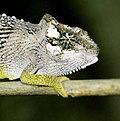
Chameleons or chamaeleons are a distinctive and highly specialized clade of Old World lizards with 200 species described as of June 2015. The members of this family are best known for their distinct range of colors, being capable of color-shifting camouflage. The large number of species in the family exhibit considerable variability in their capacity to change color. For some, it is more of a shift of brightness ; for others, a plethora of color-combinations can be seen.
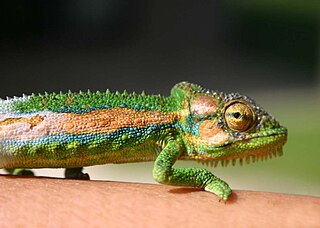
The Cape dwarf chameleon is a chameleon native to the South African province of the Western Cape, where it is restricted to the region around Cape Town.

Kinyongia is a genus of chameleons found in montane and sub-montane areas in Kenya, Tanzania, Uganda, Rwanda, Burundi, and far eastern DR Congo. They are restricted to forests, woodlands and other wooded habitats, and many species have very small geographic ranges. In most species, at least the males have horns or knobs on their noses. As typical of most chameleons, Kinyongia are oviparous.

Currently, two species are placed in the recently established genus Nadzikambia. They are plesiomorphic, small chameleons from the Ruo Gorge forest on Mount Mulanje in Malawi and Mount Mabu in Mozambique.
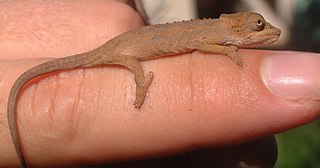
Setaro's dwarf chameleon is a species of lizard in the family Chamaeleonidae.

Smith's dwarf chameleon, also known as the Elandsberg dwarf chameleon, is a species of lizard in the family Chamaeleonidae endemic to Fynbos in South Africa's Eastern Cape. As in several species of chameleons in the genus Bradypodion, the Smith's dwarf chameleon can use its color-changing ability to actively camouflage itself depending on the vision of the specific predator species by which it is being threatened.

The Transkei dwarf chameleon or Pondo dwarf chameleon is a chameleon endemic to the Eastern Cape Province of South Africa.

The Robertson dwarf chameleon, also known as the Little Karoo dwarf chameleon, is a chameleon in the genus Bradypodion. It is found in the dry Fynbos and Renosterveld shrub vegetation, in the centre of the Western Cape province, South Africa.
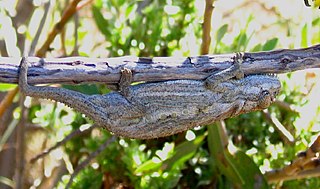
The Swartberg dwarf chameleon is a species of chameleon endemic to South Africa.
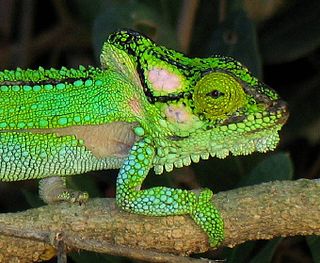
The Knysna dwarf chameleon is a species of dwarf chameleon in the Bradypodion genus that is endemic to South Africa. It is a forest dweller, found only in a limited range in the afromontane forests near Knysna, South Africa, and in certain surrounding areas.

The black-headed dwarf chameleon is a lizard of the family Chamaeleonidae endemic to KwaZulu-Natal, South Africa. It is also known as the KwaZulu dwarf chamaeleon and Durban dwarf chameleon.

The Drakensberg dwarf chameleon occurs in the Drakensberg, South Africa, between the latitudes of 27°45′ and 29°15′. Bright green dwarf chameleons found in the Drakensberg south of 29°15′ are now known to be more closely related to the Natal Midlands dwarf chameleon and may yet be described as a separate species.

The Namaqua dwarf chameleon or the western dwarf chameleon occurs in beach vegetation, along the west coast of South Africa and Namibia.
The Karoo dwarf chameleon is a chameleon native to South Africa. It is about 14 cm (6 in) long, mostly colored grey and brown, sometimes olive. The thin skin around the throat is yellow, and it has conical scales along the spine.
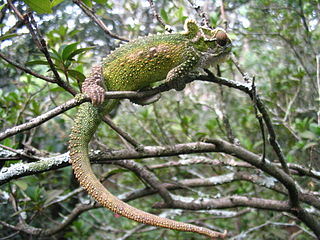
The Natal Midlands dwarf chameleon is a chameleon native to woodland habitat in the inland Midlands area of the South African province of KwaZulu-Natal.
Kinyongia carpenteri, commonly called Carpenter's chameleon or the helmeted chameleon, is a species of chameleon, a lizard in the family Chamaeleonidae. The species is native to central Africa.
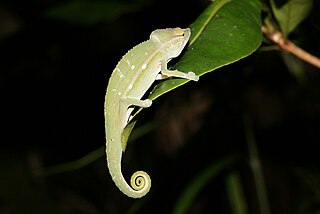
Chamaeleoninae is the nominotypical subfamily of chameleons. The Family Chamaeleonidae was divided into two subfamilies, Brookesiinae and Chamaeleoninae, by Klaver and Böhme in 1986. Since its erection in 1986, however, the validity of this subfamily designation has been the subject of much debate, although most phylogenetic studies support the notion that the pygmy chameleons of the subfamily Brookesiinae are not a monophyletic group. While some authorities have previously preferred to use the subfamilial classification on the basis of the absence of evidence principal, these authorities later abandoned this subfamilial division, no longer recognizing any subfamilies with the family Chamaeleonidae. In 2015, however, Glaw reworked the subfamilial division by placing only the genera Brookesia and Palleon within the Brookesiinae subfamily, with all other genera being placed in Chamaeleoninae.

The Family Chamaeleonidae was divided into two subfamilies, Brookesiinae and Chamaeleoninae, by Klaver and Böhme in 1986. Under this classification, Brookesiinae included the genera Brookesia and Rhampholeon, as well as the genera later split off from them. The Brookesiinae are small, often brown in colour, and occur in central Africa and Madagascar. They have terrestrial habits, or may be found in the lower levels of shrubs. Since its erection in 1986, however, the validity of this subfamily designation has been the subject of much debate, although most phylogenetic studies support the notion that the pygmy chameleons of the subfamily Brookesiinae are not a monophyletic group. While some authorities have previously preferred to use the subfamilial classification on the basis of the absence of evidence principal, these authorities later abandoned this subfamilial division, no longer recognizing any subfamilies with the family Chamaeleonidae. In 2015, however, Glaw reworked the subfamilial division by placing only the genera Brookesia and Palleon within the Brookesiinae subfamily, with all other genera being placed in Chamaeleoninae.

The Mlanje Mountain chameleon is one of two species in the genus Nadzikambia. It is a plesiomorphic, small chameleon from the Ruo Gorge forest on Mount Mulanje in Malawi.

Kinyongia boehmei, the Taita blade-horned chameleon, Böhme's two-horned chameleon and Dwarf fischer's chameleon, is species of chameleon, a lizard in the family Chamaeleonidae, found only in the Taita Hills of southeastern Kenya. It is the smallest species in the East African "two-horned chameleon" group and until 2008 it was generally considered a part of K. tavetana.



